#Yurok Tribe
Text
If you aren't following the news here in the Pacific Northwest, this is a very, very big deal. Our native salmon numbers have been plummeting over the past century and change. First it was due to overfishing by commercial canneries, then the dams went in and slowed the rivers down and blocked the salmons' migratory paths. More recently climate change is warming the water even more than the slower river flows have, and salmon can easily die of overheating in temperatures we would consider comfortable.
Removing the dams will allow the Klamath River and its tributaries to return to their natural states, making them more hospitable to salmon and other native wildlife (the reservoirs created by the dams were full of non-native fish stocked there over the years.) Not only will this help the salmon thrive, but it makes the entire ecosystem in the region more resilient. The nutrients that salmon bring back from their years in the ocean, stored within their flesh and bones, works its way through the surrounding forest and can be traced in plants several miles from the river.
This is also a victory for the Yurok, Karuk, and other indigenous people who have relied on the Klamath for many generations. The salmon aren't just a crucial source of food, but also deeply ingrained in indigenous cultures. It's a small step toward righting one of the many wrongs that indigenous people in the Americas have suffered for centuries.
#salmon#dam removal#fish#animals#wildlife#dams#Klamath River#Klamath dams#restoration ecology#indigenous rights#Yurok Tribe#Karuk Tribe#nature#ecology#environment#conservation#PNW#Pacific Northwest
13K notes
·
View notes
Text
"The Yurok will be the first Tribal nation to co-manage land with the National Park Service under a historic memorandum of understanding signed on Tuesday [March 19, 2024] by the tribe, Redwood national and state parks, and the non-profit Save the Redwoods League, according to news reports.
The Yurok tribe has seen a wave of successes in recent years, successfully campaigning for the removal of a series of dams on the Klamath River, where salmon once ran up to their territory, and with the signing of a new memorandum of understanding, the Yurok are set to reclaim more of what was theirs.
Save the Redwoods League bought a property containing these remarkable trees in 2013, and began working with the tribe to restore it, planting 50,000 native plants in the process. The location was within lands the Yurok once owned but were taken during the Gold Rush period.
Centuries passed, and by the time it was purchased it had been used as a lumber operation for 50 years, and the nearby Prairie Creek where the Yurok once harvested salmon had been buried.
Currently located on the fringe of Redwoods National and State Parks which receive over 1 million visitors every year and is a UNESCO Natural Heritage Site, the property has been renamed ‘O Rew, a Yurok word for the area.
“Today we acknowledge and celebrate the opportunity to return Indigenous guardianship to ‘O Rew and reimagine how millions of visitors from around the world experience the redwoods,” said Sam Hodder, president and CEO of Save the Redwoods League.
Having restored Prarie Creek and filled it with chinook and coho salmon, red-legged frogs, northwestern salamanders, waterfowl, and other species, the tribe has said they will build a traditional village site to showcase their culture, including redwood-plank huts, a sweat house, and a museum to contain many of the tribal artifacts they’ve recovered from museum collections.
Believing the giant trees sacred, they only use fallen trees to build their lodges.
“As the original stewards of this land, we look forward to working together with the Redwood national and state parks to manage it,” said Rosie Clayburn, the tribe’s cultural resources director.
It will add an additional mile of trails to the park system, and connect them with popular redwood groves as well as new interactive exhibits.
“This is a first-of-its-kind arrangement, where Tribal land is co-stewarded with a national park as its gateway to millions of visitors. This action will deepen the relationship between Tribes and the National Park Service,” said Redwoods National Park Superintendent Steve Mietz, adding that it would “heal the land while healing the relationships among all the people who inhabit this magnificent forest.”"
-via Good News Network, March 25, 2024
#indigenous#land back#indigenous issues#first nations#native american#indigenous peoples#yurok#yurok tribe#national parks service#national park#redwoods#california#trees#trees and forests#united states#good news#hope#indigenous land
5K notes
·
View notes
Text
California’s Yurok Tribe, which had 90% of its territory taken from it during the gold rush of the mid-1800s, will be getting a slice of its land back to serve as a new gateway to Redwood national and state parks visited by 1 million people a year.
The Yurok will be the first Native people to manage tribal land with the National Park Service under a historic memorandum of understanding signed on Tuesday by the tribe, Redwood national and state parks and the non-profit Save the Redwoods League.
The agreement “starts the process of changing the narrative about how, by whom and for whom we steward natural lands”, Sam Hodder, president and CEO of Save the Redwoods League, said in a statement.
The return of the 125 acres (50 hectares) of land – named ’O Rew in the Yurok language – more than a century after it was stolen from California’s largest tribe is proof of the “sheer will and perseverance of the Yurok people”, said Rosie Clayburn, the tribe’s cultural resources director. “We kind of don’t give up.”
For the tribe, redwoods are considered living beings and traditionally only fallen trees have been used to build their homes and canoes.
“As the original stewards of this land, we look forward to working together with the Redwood national and state parks to manage it,” Clayburn said. “This is work that we’ve always done, and continued to fight for, but I feel like the rest of world is catching up right now and starting to see that Native people know how to manage this land the best.”
The property is at the heart of the tribe’s ancestral land and was taken in the 1800s to exploit its old-growth redwoods and other natural resources, the tribe said. Save the Redwoods League bought the property in 2013 and began working with the tribe and others to restore it.
Much of the property was paved over by a lumber operation that worked there for 50 years and also buried Prairie Creek, where salmon would swim upstream from the Pacific to spawn.
Plans for ’O Rew include a traditional Yurok village of redwood plank houses and a sweat house. There also will be a new visitor and cultural center displaying scores of sacred artefacts from deerskins to baskets that have been returned to the tribe from university and museum collections, Clayburn said.
It will add more than a mile (1.6km) of new trails, including a new segment of the California Coastal Trail, with interpretive exhibits. The trails will connect to many of the existing trails inside the parks, including to popular old-growth redwood groves.
The tribe had already been restoring salmon habitat for three years on the property, building a meandering stream channel, two connected ponds and about 20 acres (8 hectares) of floodplain while dismantling a defunct mill site. Crews also planted more than 50,000 native plants, including grass-like slough sedge, black cottonwood and coast redwood trees.
Salmon were once abundant in rivers and streams running through these redwood forests, But dams, logging, development and drought – due in part to the climate crisis – have destroyed the waterways and threatened many of these species. Last year, recreational and commercial king salmon fishing seasons were closed along much of the west coast due to near-record low numbers of the iconic fish returning to their spawning grounds.
The tribe will take ownership in 2026 of the land near the tiny northern California community of Orick in Humboldt county after restoration of a local tributary, Prairie Creek, is complete under the deal.
A growing Land Back movement has been returning Indigenous homelands to the descendants of those who lived there for millennia before European settlers arrived. That has seen Native American tribes taking a greater role in restoring rivers and lands to how they were before they were expropriated.
Last week, a 2.2-acre (0.9-hectare) parking lot was returned to the Ohlone people where they established the first human settlement beside San Francisco Bay 5,700 years ago. In 2022, more than 500 acres (200 hectares) of redwood forest on the Lost Coast were returned the InterTribal Sinkyone Wilderness Council, a group of 10 tribes.
The ’O Rew property represents just a tiny fraction of the more than 500,000 acres of the ancestral land of the Yurok, whose reservation straddles the lower 44 miles (70km) of the Klamath River. The Yurok tribe is also helping lead efforts in the largest dam removal project in US history along the California-Oregon border to restore the Klamath and boost the salmon population.
The Redwoods national park superintendent, Steve Mietz, praised the restoration of the area and its return to the tribe, saying it is “healing the land while healing the relationships among all the people who inhabit this magnificent forest”.
#excerpts#yurok tribe#national parks#California#environment#indigenous rights#tribal rights#land back#national park service#ecosystems#biodiversity#salmon
25 notes
·
View notes
Text

Yurok tribal members lead a redwood canoe tour on the lower Klamath River on Tuesday, June 8, 2021, in Klamath, Calif. (AP Photo/Nathan Howard, File)
(I could have sworn I read this in a post on here, but I just cannot find it anywhere. So here it is... maybe again for some folks.)
California tribe that lost 90% of land during Gold Rush to get site to serve as gateway to redwoods
By Associated Press Laguna Beach
PUBLISHED 4:54 PM PT Mar. 19, 2024
Source.
California’s Yurok Tribe, which had 90% of its territory taken from it during the Gold Rush of the mid-1800s, will be getting a slice of its land back to serve as a new gateway to Redwood National and State Parks visited by 1 million people a year.
The tribe signed a memorandum of understanding Tuesday with California and the National Park Service for 125 acres in Humboldt County to be transferred to the Yurok in 2026 after the restoration of salmon habitat Officials say the tribe will be the first Native people to co-manage returned land with the National Park Service The arrangement with the Redwood National and State Parks and the nonprofit Save the Redwoods League is part of a growing Land Back movement It seeks to return Indigenous homelands to descendants of those who inhabited those areas long before European settlers arrived
The Yurok will be the first Native people to manage tribal land with the National Park Service under a historic memorandum of understanding signed Tuesday by the tribe, Redwood National and State Parks and the nonprofit Save the Redwoods League.
The agreement “starts the process of changing the narrative about how, by whom and for whom we steward natural lands,” Sam Hodder, president and CEO of Save the Redwoods League, said in a statement.
The tribe will take ownership in 2026 of 125 acres near the tiny Northern California community of Orick in Humboldt County after restoration of a local tributary, Prairie Creek, is complete under the deal. The site will introduce visitors to Yurok customs, culture and history, the tribe said.
The area is home to the world’s tallest treees — some reaching more than 350 feet. It’s about a mile from the Pacific coast and adjacent to the Redwood National and State Parks, which includes one national park and three California state parks totaling nearly 132,000 acres.
The return of the land — named ’O Rew in the Yurok Language — more than a century after it was stolen from California’s largest tribe is proof of the “sheer will and perseverance of the Yurok people,” said Rosie Clayburn, the tribe’s cultural resources director. “We kind of don’t give up.”
For the tribe, redwoods are considered living beings and traditionally only fallen trees have been used to build their homes and canoes.
More below the cut:

This drone photo taken Monday, Jan. 29, 2024, shows the site of a salmon restoration project at Prairie Creek, which runs from Redwood National and State Parks, Calif., and flows through land that will be returned to the Yurok Tribe. (AP Photo/Terry Chea, File)
“As the original stewards of this land, we look forward to working together with the Redwood National and State Parks to manage it,” Clayburn said. “This is work that we’ve always done, and continued to fight for, but I feel like the rest of world is catching up right now and starting to see that Native people know how to manage this land the best.”
The property is at the heart of the tribe’s ancestral land and was taken in the 1800s to exploit its old-growth redwoods and other natural resources, the tribe said. Save the Redwoods League bought the property in 2013 and began working with the tribe and others to restore it.
Much of the property was paved over by a lumber operation that worked there for 50 years and also buried Prairie Creek, where salmon would swim upstream from the Pacific to spawn.
A growing Land Back movement has been returning Indigenous homelands to the descendants of those who lived there for millennia before European settlers arrived. That has seen Native American tribes taking a greater role in restoring rivers and lands to how they were before they were expropriated.
Last week, a 2.2-acre parking lot was returned to the Ohlone people where they established the first human settlement beside San Francisco Bay 5,700 years ago. In 2022, more than 500 acres of redwood forest on the Lost Coast were returned to the InterTribal Sinkyone Wilderness Council, a group of 10 tribes.
The ’O Rew property represents just a tiny fraction of the more than 500,000 acres of the ancestral land of the Yurok, whose reservation straddles the lower 44 miles of the Klamath River. The Yurok tribe is also helping lead efforts in the largest dam removal project in U.S. history along the California-Oregon border to restore the Klamath and boost the salmon population.
Plans for ‘O Rew include a traditional Yurok village of redwood plank houses and a sweat house. There also will be a new visitor and cultural center displaying scores of sacred artefacts from deerskins to baskets that have been returned to the tribe from university and museum collections, Clayburn said.
The center, which will include information on the redwoods and forest restoration, also will serve as a hub for the tribe to carry out their traditions, she said.
It will add more than a mile of new trails, including a new segment of the California Coastal Trail, with interpretive exhibits. The trails will connect to many of the existing trails inside the parks, including to popular old-growth redwood groves.

This drone photo taken on Monday, Jan. 29, 2024, shows a salmon restoration project at Prairie Creek, which runs from Redwood National and State Parks, Calif., and flows through land that will be returned to the Yurok Tribe. (AP Photo/Terry Chea)
The tribe had already been restoring salmon habitat for three years on the property, building a meandering stream channel, two connected ponds and about 20 acres of floodplain while dismantling a defunct mill site. Crews also planted more than 50,000 native plants, including grass-like slough sedge, black cottonwood and coast redwood trees.
Salmon were once abundant in rivers and streams running through these redwood forests. But dams, logging, development and drought — due in part to climate change — have destroyed the waterways and threatened many of these species. Last year, recreational and commercial king salmon fishing seasons were closed along much of the West Coast due to near-record low numbers of the iconic fish returning to their spawning grounds.
Thousands of juvenile coho and chinook salmon and steelhead have already returned to Prairie Creek along with red-legged frogs, northwestern salamanders, waterfowl and other species.
Redwoods National Park Superintendent Steve Mietz praised the restoration of the area and its return to the tribe, saying it is “healing the land while healing the relationships among all the people who inhabit this magnificent forest.”
#redwoods#redwoods national park#yurok#yurok tribe#national parks#california#environmentalism#conservation#indigenous stories#some good news!#ids in alt
11 notes
·
View notes
Text
the world is bad and i need good news where i can get it so it was very moving for me to see california condors fly in yurok skies again for the first time since 1892 yesterday morning.
(here is a video of the event if you want to see these birds come home.)
#the yurok tribe is very often looked over and dismissed during discussions of condor conservation (gee wonder why)#and this is such a wonderful historic moment that came from their activism and stewardship#this has been building for awhile and i'm so happy the day has finally come. the condors are home.
13 notes
·
View notes
Text
Cristen Hemingway Jaynes: Yurok Tribe Becomes First to Steward Land with National Park Service
Restoring Prairie Creek to ecological integrity is part of the plan for the 125-acre ‘O Rew Redwoods Gateway, which represents a first-ever model for tribal, federal, and state co-management of nationally significant land, with an Indigenous tribe at the helm. CalTrout / Michael Wier.
California’s Yurok Tribe had 90 percent of its territory stolen during the mid-1800s gold rush. Now, it will be…

View On WordPress
#Cristen Hemingway Jaynes#National Park Service#Native American#Redwoods#restoration#wilding#Yurok#Yurok Tribe Becomes First to Steward Land with National Park Service
0 notes
Text
Video Source | Yurok Tribe | Save California Salmon | Redwoods Rising
17K notes
·
View notes
Text
CA Redwoods to Be First National Park Co-Managed with a Native American Tribe That Used to Own it https://www.goodnewsnetwork.org/ca-redwoods-to-be-the-first-national-park-co-managed-with-a-native-american-tribe-that-used-to-own-it/
questionable headline aside this is good news
The Yurok will be the first Tribal nation to co-manage land with the National Park Service under a historic memorandum of understanding signed on Tuesday by the tribe, Redwood national and state parks, and the non-profit Save the Redwoods League, according to news reports.
The Yurok tribe has seen a wave of successes in recent years, successfully campaigning for the removal of a series of dams on the Klamath River, where salmon once ran up to their territory, and with the signing of a new memorandum of understanding, the Yurok are set to reclaim more of what was theirs.
#good news#environmentalism#science#canada#redwoods#yurok#save the redwoods league#not really land back#but still a good step#nature#stewardship#indigenous#indigenous land stewardship#environment#conservation#animals#trees#forests
3K notes
·
View notes
Text
Indigenous People's Day

DR. HENRIETTA MANN
Cheyenne
On this Indigenous People’s Day, we are featuring Matika Wilbur’s recent publication Project 562: Changing the Way We See Native America, published by Ten Speed Press in 2023. Wilbur (b. 1984) is a visual storyteller and member of the Swinomish and Tulalip peoples of coastal Washington. She holds a degree from the Brooks Institute of Photography alongside a teaching certificate that has shaped her style of educating through narrative portraits.
Project 562: Changing the Way We See Native America, a book born from a documentary project of the same name, resolves to share contemporary Native issues and culture. In 2012 Wilbur set out from Seattle to visit and photograph all 562 plus Native American sovereign territories in the United States.
Wilbur’s engagement with the communities she visited resulted in the creation of hundreds of dynamic portraits and documentation of conversations about “tribal sovereignty, self-determination, wellness, recovery from historical trauma, decolonization of the mind, and revitalization of culture.” She refers to her portraiture approach as “an indigenous photography method” that includes several hours and sometimes days of interaction with the participants, an exchange of energy and gifts, and asking sitters to choose their portrait location. The outcome is a stunning collection of Native narratives and portraits.
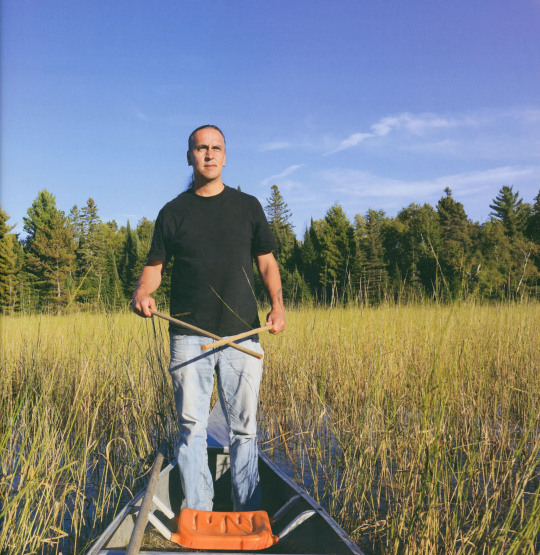
GREG BISKAKONE JOHNSON
Lac Du Flambeau Band of Lake Superior Chippewa Indians
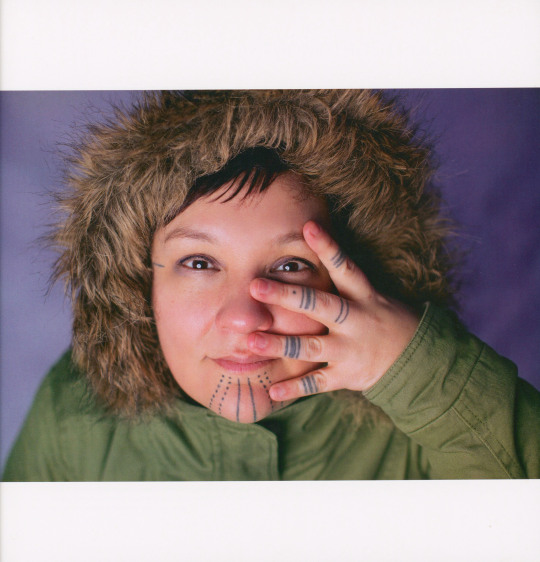
HOLLY MITITQUQ NORDLUM
Iñupiaq
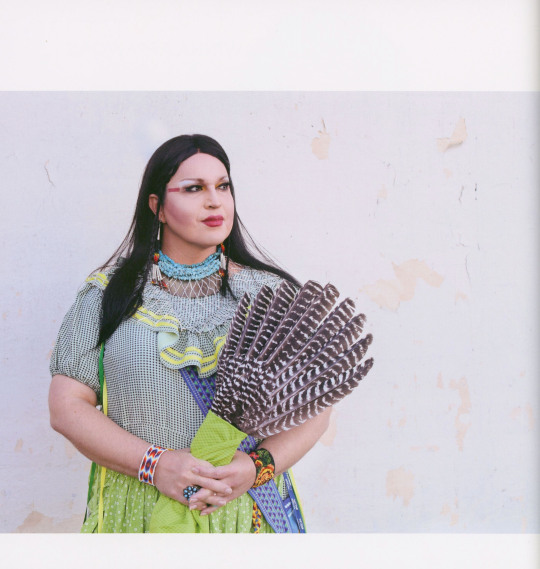
J. MIKO THOMAS
Chickasaw Nation

MOIRA REDCORN
Osage, Caddo

HELENA and PRESTON ARROW-WEED
Taos Pueblo/Kwaatsaan, Kamia
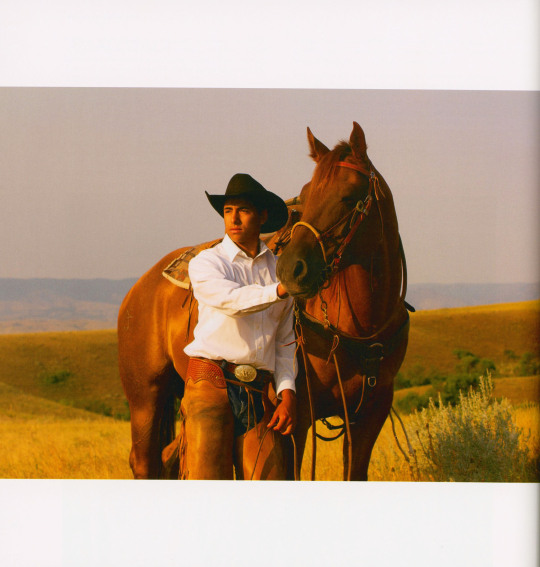
STEPHEN YELLOWTAIL
Apsáalooke (Crow Nation)
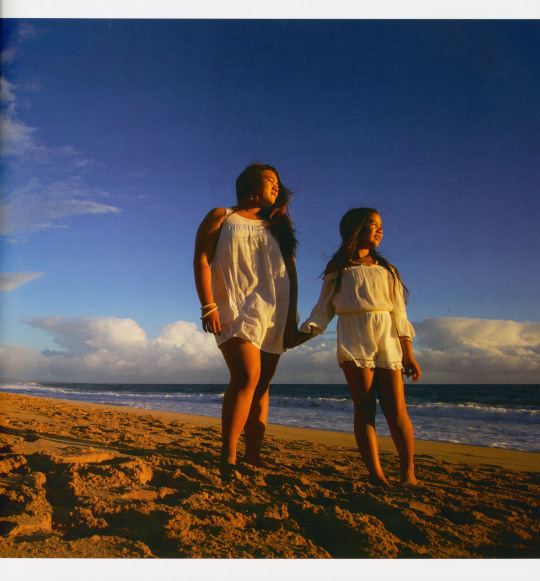
LEI'OHU and LA'AKEA CHUN
Kānaka Maoli
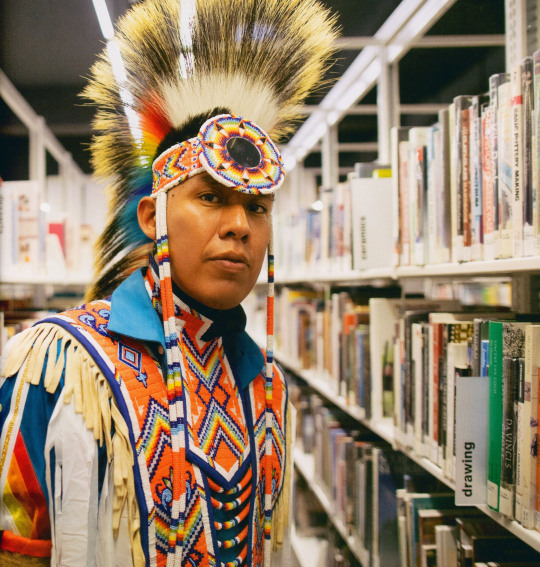
ORLANDO BEGAY
Diné
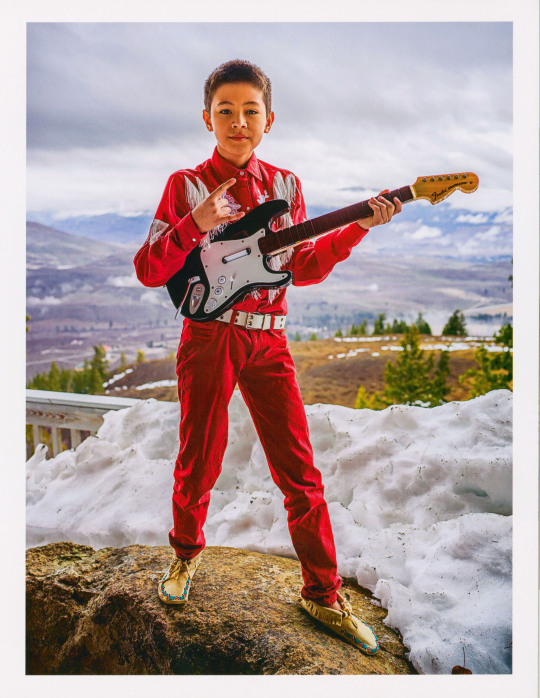
KALE NISSEN
Colville Tribes
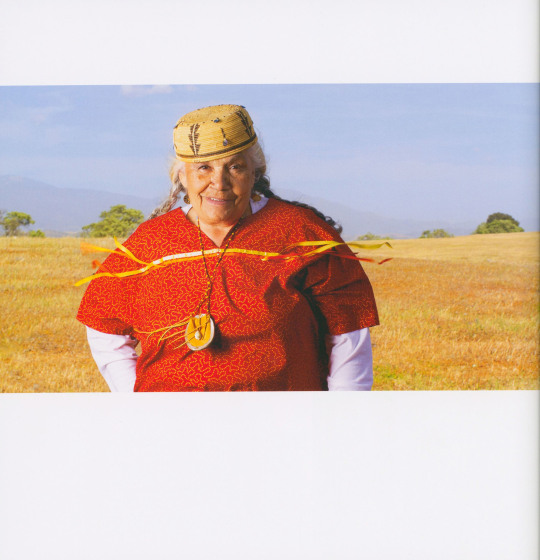
GRACE ROMERO PACHECO
Santa Ynez Band of Chumash Indians
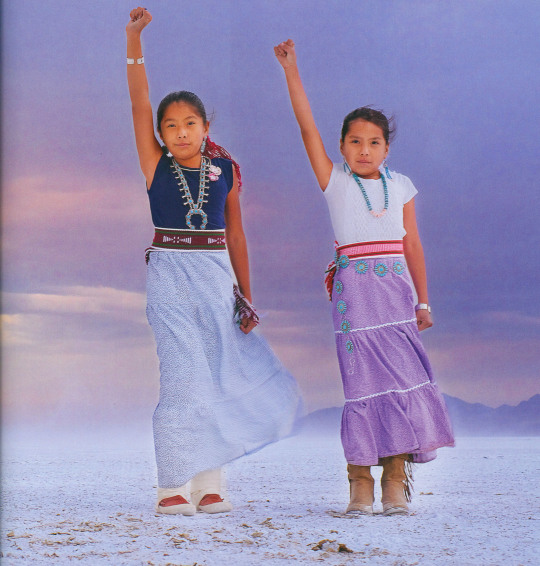
ISABELLA and ALYSSA KLAIN
Diné
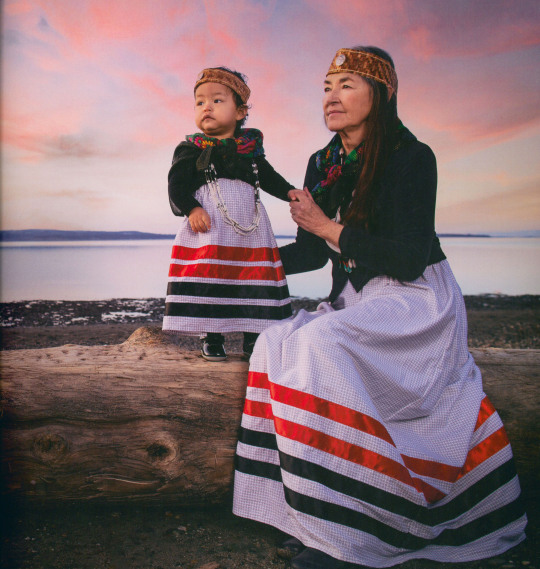
NANCY WILBUR
Swinomish
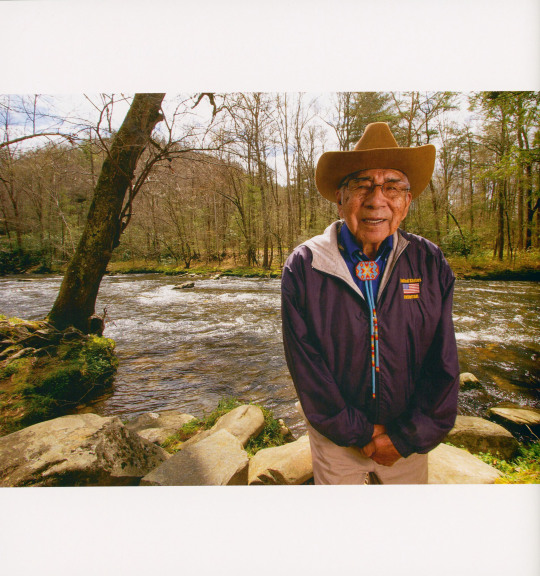
DR. JEREMIAH "JERRY" WOLFE
Eastern Band of Cherokee Indians
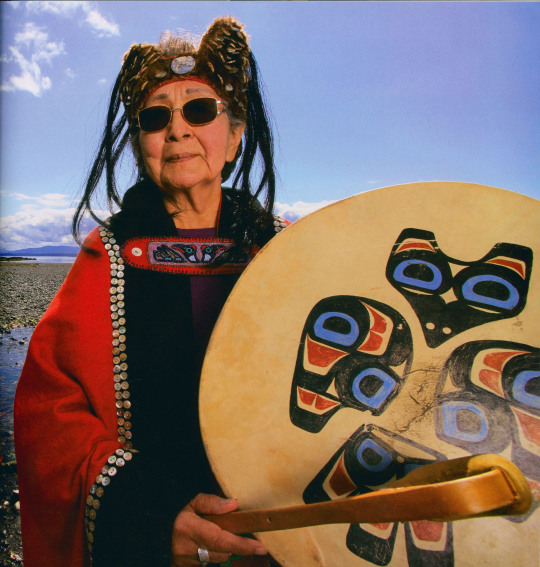
RUTH DEMMERT
Tlingit
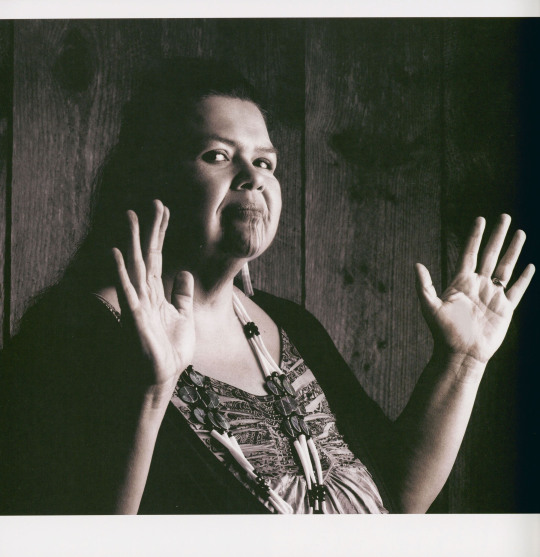
MARVA SII~XUUTESNA JONES
Tolowa Dee-Ni' Nation, Yurok, Karuk, Wintu
Matika Wilbur will be speaking on UW-Milwaukee's campus Thursday, November 16 from 6-7p.m. in conjunction with her exhibition Seeds of Culture: The Portraits and Voices of Native American Women on view at the Union Art Gallery November 16 through December 15, 2023.
-Jenna, Special Collections Graduate Intern
We acknowledge that in Milwaukee we live and work on traditional Potawatomi, Ho-Chunk, and Menominee homelands along the southwest shores of Michigami, part of North America’s largest system of freshwater lakes, where the Milwaukee, Menominee, and Kinnickinnic rivers meet and the people of Wisconsin’s sovereign Anishinaabe, Ho-Chunk, Menominee, Oneida, and Mohican nations remain present.
#indigenous people's day#matika wilbur#project 562#Ten Speed Press#Native Americans#holidays#UWM Native American Literature Collecton
810 notes
·
View notes
Text
Listen. LISTEN, the longer I spend in the academic world, I am more convinced that describing Judaism and Jews as a religion/ethnic grope/ethnoreligion is unhelpful outside of Academic circles.
The best way to explain Judaism is using the tribe model. A lot of times Judaism is a community first and a religion second, i.e., your level of religiousness is rarely a thing that alienate you from the community.
Think of other tribes, like the Sámi, Aboriginal Australians, Māori, Yurok, Inuit ect. Each have their own unique religion, but we do not think of them as a religious group, because the tribal identity is more important, and the religion is considered part of the culture, not the opposite.
IMORTANT SIDENOTE: I am aware that many of those tribes, and other tribes have a big chunk of Christians in them, usually more Christians than those who follow the indigenous religion of the tribe. BUT for the sake of discussion, I am equating Judaism to the section that does follow the indigenous religion of the tribe.
So, despite the fact that the religious structures of Judaism is very integral to Judaism, it is partly because of the community based focus of Judaism. The most basic example is the Minyan, the fact that prayer is preferred to be done in a group. Or the fact that the Sader is meant to be a celebrated in a group. and so on.
SO, ethnoreligion is a great academic term, but for outside that world? A tribe is a much better term to explain Judaism.
#jumblr#judaism#ethnoreligion#the problem of using academic terms outside academia is that they require the ACADEMIC CONTEXT#and I found that presenting Jews as a tribe makes a lot of the comparison to Christianity go away#and helps explain the solidarity a lot of Jews find toward other indigenous tribes#because we have a lot in common#the Jewish tribe is just far more spread out than most tribes#yes#this is an oversimplification#but sometimes you have to do it in order to get the point#Judaism is a closed practice#just like the faith of many other tribes
1K notes
·
View notes
Text

Headline by: Ryan Burns. “Ground Has Been Broken on Klamath River Restoration, the World’s Largest-Ever Dam-Removal Project.” Lost Coast Outpost. 23 March 2023.
---

The world’s largest dam removal in history is slated for 2023. Led by Indigenous tribes in partnership with organizations, lawyers, scientists and activists, the project will remove four dams, clearing the way for the lower Klamath River to flow freely for the first time in more than a century.
Headline and italicized text excerpt by: Malia Russ. “The Science of Saving Salmon as Klamath Dams Come Down.” UC Davis - Blogs - Climate. 24 February 2023.
---
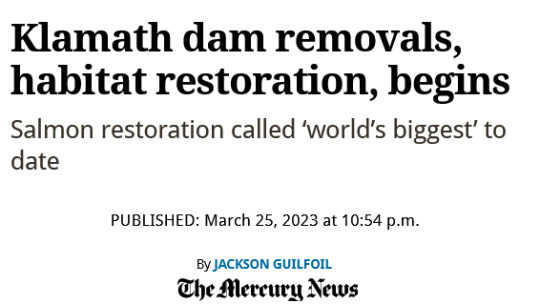
Headline by: Jackson Guilfoil. “Klamath dam removals, habitat restoration, begins.” The Mercury News. 25 March 2023.
---
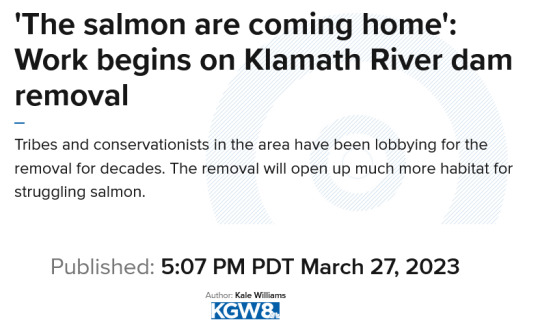
Headline by: Kale Williams. “‘The salmon are coming home’: Work begins on Klamath River dam removal.” KGW8. 27 March 2023.
---

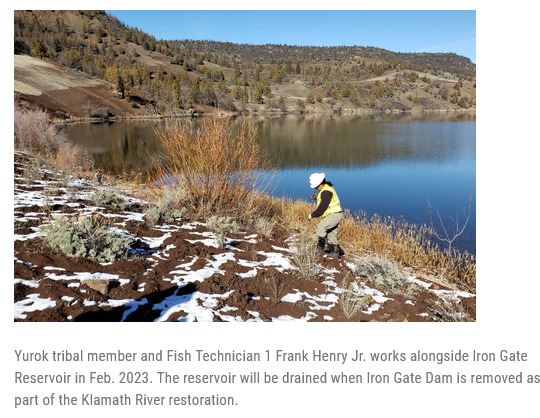
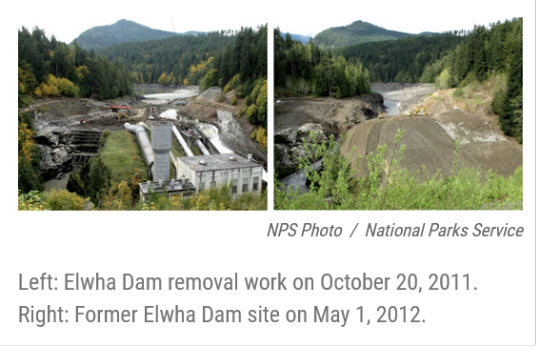
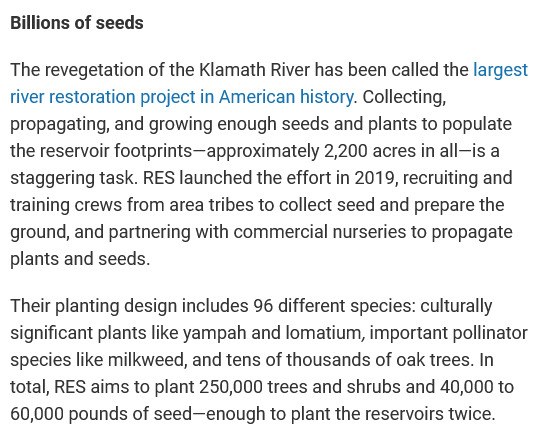
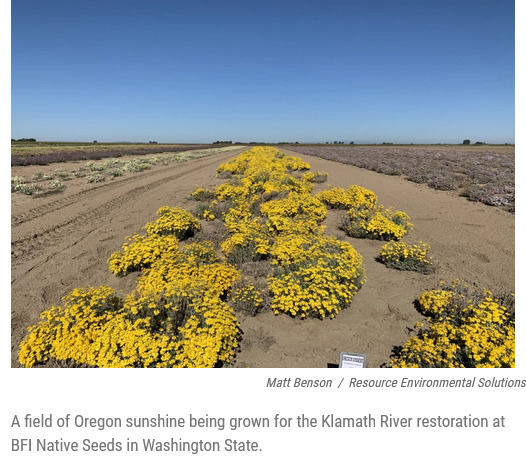
Iron Gate is a sinuous, skinny reservoir tucked into the folds of the Siskiyou Mountains. Draining it will expose about 900 acres of wet mud. “It’s our job to make sure it’s revegetated. We want that to be revegetated with a healthy native plant ecosystem,” says Joshua Chenoweth, Senior Riparian Ecologist for the Yurok Tribe who is leading the replanting effort. [...] Last fall, they seeded the strip with a mix of native grasses and flowering plants; now, they’re installing young shrubs and trees: buckbrush, serviceberry, and Oregon ash, along with the Klamath plum. Collectively, these plants will create a “wall of green,” taking up space that would have otherwise been overrun by non-native plants [...]. The revegetation of the Klamath River has been called the largest river restoration project in American history. Collecting, propagating, and growing enough seeds and plants to populate the reservoir footprints -- approximately 2,200 acres in all -- is a staggering task. [...] Their planting design includes 96 different species: culturally significant plants like yampah and lomatium, important pollinator species like milkweed, and tens of thousands of oak trees. [...] What will a restored, wild Klamath River look like? Imagine it. Stand at the Wanaka Springs boat launch and picture Iron Gate reservoir drained. The river has found its channel at the base of its original canyon. Willows flank the banks. Much of the reservoir footprint is flush with upland vegetation -- oak copses; thickets of buckbrush and Klamath plum; blooming rose and lupine.
---
Headline, images, captions, screenshot, and italicized text excerpt from: Juliet Grable. “After the dams: Restoring the Klamath River will take billions of native seeds.” Jefferson Public Radio. 13 March 2023.
2K notes
·
View notes
Text
The Klamath River’s salmon population has declined due to myriad factors, but the biggest culprit is believed to be a series of dams built along the river from 1918 to 1962, cutting off fish migration routes.
Now, after decades of Indigenous advocacy, four of the structures are being demolished as part of the largest dam removal project in United States history. In November, crews finished removing the first of the four dams as part of a push to restore 644 kilometres (400 miles) of fish habitat.
“Dam removal is the largest single step that we can take to restore the Klamath River ecosystem,” [Barry McCovey, a member of the Yurok Tribe and director of tribal fisheries,] told Al Jazeera. “We’re going to see benefits to the ecosystem and then, in turn, to the fishery for decades and decades to come.” ...
A ‘watershed moment’
Four years later, [after a catastrophic fish die-off in 2002,] in 2006, the licence for the hydroelectric dams expired. That created an opportunity, according to Mark Bransom, CEO of the Klamath River Renewal Corporation (KRRC), a nonprofit founded to oversee the dam removals.
Standards for protecting fisheries had increased since the initial license was issued, and the utility company responsible for the dams faced a choice. It could either upgrade the dams at an economic loss or enter into a settlement agreement that would allow it to operate the dams until they could be demolished.
“A big driver was the economics — knowing that they would have to modify these facilities to bring them up to modern environmental standards,” Bransom explained. “And the economics just didn’t pencil out.”
The utility company chose the settlement. In 2016, the KRRC was created to work with the state governments of California and Oregon to demolish the dams.
Final approval for the deal came in 2022, in what Bransom remembers as a “watershed moment”.
Regulators at the Federal Energy Regulatory Commission (FERC) voted unanimously to tear down the dams, citing the benefit to the environment as well as to Indigenous tribes...
Tears of joy
Destruction of the first dam — the smallest, known as Copco 2 — began in June, with heavy machinery like excavators tearing down its concrete walls.
[Amy Cordalis, a Yurok Tribe member, fisherwoman and lawyer for the tribe,] was present for the start of the destruction. Bransom had invited her and fellow KRRC board members to visit the bend in the Klamath River where Copco 2 was being removed. She remembers taking his hand as they walked along a gravel ridge towards the water, a vein of blue nestled amid rolling hills.
“And then, there it was,” Cordalis said. “Or there it wasn’t. The dam was gone.”
For the first time in a century, water flowed freely through that area of the river. Cordalis felt like she was seeing her homelands restored.
Tears of joy began to roll down her cheeks. “I just cried so hard because it was so beautiful.”
The experience was also “profound” for Bransom. “It really was literally a jolt of energy that flowed through us,” he said, calling the visit “perhaps one of the most touching, most moving moments in my entire life”.
Demolition on Copco 2 was completed in November, with work starting on the other three dams. The entire project is scheduled to wrap in late 2024.
[A resilient river]
But experts like McCovey say major hurdles remain to restoring the river’s historic salmon population.
Climate change is warming the water. Wildfires and flash floods are contaminating the river with debris. And tiny particles from rubber vehicle tires are washing off roadways and into waterways, where their chemicals can kill fish within hours.
McCovey, however, is optimistic that the dam demolitions will help the river become more resilient.
“Dam removal is one of the best things we can do to help the Klamath basin be ready to handle climate change,” McCovey explained. He added that the river’s uninterrupted flow will also help flush out sediment and improve water quality.
The removal project is not the solution to all the river’s woes, but McCovey believes it’s a start — a step towards rebuilding the reciprocal relationship between the waterway and the Indigenous people who rely on it.
“We do a little bit of work, and then we start to see more salmon, and then maybe we get to eat more salmon, and that starts to help our people heal a little bit,” McCovey said. “And once we start healing, then we’re in a place where we can start to help the ecosystem a little bit more.”"
-via Al Jazeera, December 4, 2023
#indigenous#river#riverine#ecosystem#ecosystem restoration#klamath#klamath river#oregon#california#yurok#fishing#fisheries#nature is healing#literally this time lol#united states#dam removal#climate change#conservation#sustainability#salmon#salmon run#water quality#good news#hope#rewilding#ecology#environment
5K notes
·
View notes
Text
California’s Yurok Tribe, which had 90% of its territory taken from it during the Gold Rush of the mid-1800s, will be getting a slice of its land back to serve as a new gateway to Redwood National and State Parks visited by 1 million people a year.
The Yurok will be the first Native people to manage tribal land with the National Park Service under a historic memorandum of understanding signed Tuesday by the tribe, Redwood National and State Parks and the nonprofit Save the Redwoods League.
The agreement “starts the process of changing the narrative about how, by whom and for whom we steward natural lands,” Sam Hodder, president and CEO of Save the Redwoods League, said in a statement.
81 notes
·
View notes
Text

💥 PUNK CONDOR ADOPT! 💥
today, september 2nd, is international vulture awareness day! this condor is up for USD offers - winner will donate the amount directly to the peregrine fund OR yurok tribe condor conservation programs! see replies for toyhouse link :]
#anthro#furry#fursona#anthro avian#anthro vulture#vulture#condor#california condor#punk#queer#lgbt#lesbian#trans#sfw furry#clean furry#adopt#adoptable#open adopt#character design#stanley does art
206 notes
·
View notes
Note
Longtime follower, first time interacting:
No question, just wanted to share some good news out of a local community. I'm a school teacher in northern california in a region with a lot of Natives and also a region where a lot of white people have a generally...well, it doesn't compare to the depth of trauma Native people have but there are deep scars here from CAMP and the number of families torn apart and family farms torched by the DEA.
So no one here loves the government.
But when a lot of the local tribes got turned down for language funding by the Fed, it actually wound up making the county officials interested in fundraising education programs at the local schools to help native kids learn their ancestral tongues.
Well, them, and settler kids who were either invited, just wanted to learn, had indigenous ancestry but not tribal culture (lot of intermarriage up here).
The motive was partially spite for the federal government, but it seems to have had good effects - there's enough second-language speakers that at least Yurok and Wiyot are starting to turn around their fights for language preservation.
Thought in the midst of all the tragedy and national failure you could do with some positive news from a local theater.
HOPE
😭😭😭😭
51 notes
·
View notes
Text
The tribes, environmentalists and their allies celebrated the shrinking waters as an essential next step in what they say will be a decades-long process of restoring one of the West's largest salmon fisheries and a region the size of West Virginia back to health.
Yurok tribal member and fisheries director Barry McCovey was amazed at how fast the river and the lands surrounding the Copco dam were revealed.
"The river had already found its path and reclaimed its original riverbed, which is pretty amazing to see," he said. The 6,500-member tribe's lands span the Klamath's final 44 miles to the Pacific Ocean, and the Yurok and other tribes that depend on the Klamath for subsistence and cultural activities have long advocated for the dams' removal and for ecological restoration.
Amid the largest-ever dam removal in the U.S., rumors and misunderstandings have spread through social media, in grange halls and in local establishments. In the meantime, public agencies and private firms race to correct misinformation by providing facts and real data on how the Klamath is recovering from what one official called "major heart surgery."
But while dam removal continues, a coalition of tribes, upper Klamath Basin farmers, and the Biden administration have struck a new deal to restore the Klamath Basin and improve water supplies for birds, fish and farmers alike.
...
The Yurok Tribe also contracted with Resource Environmental Solutions to collect the billions of seeds from native plants needed to restore the denuded lands revealed when the waters subsided.
The company, known to locals as RES, took a whole-ecological approach while planning the project. In addition to rehabbing about 2,200 acres of land exposed after the four shallow reservoirs finish draining, "we have obligations for a number of species, including eagles and Western pond turtles," said David Coffman, RES' Northern California and Southern Oregon director.
...
The company also plans to support important pollinators like native bumblebees and monarch butterflies and protect species of special concern like the willow flycatcher. And, Coffman said, removal of invasive plant species like star thistle is also underway. In some cases, he said, workers will pull any invasives out by hand if they notice them encroaching on newly planted areas.
...
The Interior Department announced Wednesday that the agency had signed a deal with the Yurok, Karuk and Klamath Tribes and the Klamath Basin Water Users Association to collaborate on Klamath Basin restoration and improving water reliability for the Klamath Project, a federal irrigation and agricultural project.
An Interior Department spokesperson said the agency had been meeting with river tribes and the farmers of the Upper Basin for the first time in a decade to develop a plan to restore basin health, support fish and wildlife in the region, and support agriculture in the Upper Basin.
"We're trying to make it as healthy as possible and restore things like wetlands, natural stream channels and forested watershed," the spokesperson said. He likened it to keeping the "sponge" wetlands provide to store water wet. The effort is meant to be a cross-agency and cross-state process.
The Biden administration also announced $72 million in funding for ecosystem restoration and agricultural infrastructure modernization throughout the Klamath Basin from the Bipartisan Infrastructure Act.
10 notes
·
View notes